
|
|
|
|
 |
|
Home Site Search Contact Us Subscribe
|
|
|
|
So Tall: International High-Rise Prize 2006 Goes to Barcelona's Torre Agbar by Jean Nouvel
Commendations to: Calatrava; Delugan Meissl Architects; mecanoo architecten; and Riken Yamamoto & Field Shop by ArchNewsNow May 22, 2006 Spain’s star continues to rise in the architectural firmament with the announcement on May 16 of the winner of the second International High-Rise Prize: the striking 142-meter-high Torre Agbar, headquarters for the Catalan metropolis’s water utility, Aigües de Barcelona/Sociedad General de Aguas de Barcelona SA (known as Agbar), designed by Paris-based Ateliers Jean Nouvel.
The innovative façade of the 35-story tower sports aluminum panels in 25 different colors mounted to the concrete skin. Depending on the time of day, the tower’s skin changes from dramatic red to blue hues, topped by a white dome of glass and steel. Positioned in front of 4,400 square windows in the concrete shell, 60,000 glass blinds form an additional outer skin that that optimize transparency from the interior of the building while providing thermal protection.
The jury also issued four commendations, all of them for residential high-rises. They are: the 190-meter-high Turning Torso in Malmö, Sweden, by Santiago Calatrava (Valencia and Zurich); the 106-meter-high residential Wienerberg sky-rise by Delugan Meissl Architects (Vienna); the 152-meter-high Montevideo in Rotterdam by mecanoo architecten b.v. (Delft); and the 100-meter-high mixed-use project Jian Wai SOHO in Beijing by Riken Yamamoto & Field Shop (Yokohama).
The jury, chaired by Prof. Werner Sobek (engineer/Stuttgart), included: Johannes Haug (engineer, MD Deka Immobilien Investment); David M. Leventhal (architect/KPF London and 2004 High-Rise Prize winner); Dr. Hans-Bernhard Nordhoff (Head of the City of Frankfurt Cultural Dept.); and Prof. Peter P. Schweger (architect/Hamburg). A total of 19 entries from 11 countries were short-listed for the jury’s consideration. In keeping with current trends in high-rise construction, buildings in Asia and/or designed by Asian firms represented one third of the entries. (Interestingly, although several U.S. architects worked on submitted projects, not one high-rise built in the United States was submitted.) The awards ceremony will be held November 17, 2006, at Frankfurt’s Paulskirche.
Deutsches Architektur Museum (DAM) in Frankfurt, which initiated and organizes the prize, will open a major high-rise exhibition entitled “High Society” on November 18, 2006. It will present a cross-section of current plans world-wide for high-rise construction. The focus will be on the winner of the International High-Rise Prize and the projects commended by the jury.
The 2006 Prize is part of a cooperative agreement between the City of Franfurt/Main and DekaBank running through 2008, and is the second time since 2004 that the €50,000 purse has been awarded. To be considered, submissions must be a completed building that is at least 100 meters tall, displays pioneering design, innovative technology, cost efficiency, and “is meaningfully embedded in the urban fabric.” The Prize is awarded to both the architect(s) and developer(s) of high-rise buildings (the architect receives the monetary prize).
Jury Comments
Project: Torre Agbar, Barcelona Architect: Ateliers Jean Nouvel, Paris Developer: Aigües de Barcelona / Sociedad General de Aguas de Barcelona SA
Torre Agbar is awarded the International High-Rise Prize 2006 because it makes an outstanding contribution to the current debate on high-rises on several different levels.
It is the symbol for the development of a new district in Barcelona. Its expressive shape highlights the pulsating dynamism of a revitalized quarter thanks to urban planning. The architectural form is reduced to an elementary gesture, while remaining complex in terms of geometry. A multi-layer outer skin generates its varied and exciting appearance.
Unlike the customary high-rises with glass curtain façades, the skin of the Torre Agbar responds to the hot Spanish climate. The building’s shaft comprises a concrete outer wall that is penetrated, seemingly irregularly, by individual window openings. In this way, the massive concrete wall provides not only stability for the tower, but also a shield against the heat. An additional outer layer made up of moving glass blinds forms a thermal buffer zone to the massive concrete skin behind it. In this way, an energy-conscious structure emerges using simple intelligent means rather than great technological expense.
Inside the building, the off-center arrangement of the core allows for large interconnected rooms that engender a sense of openness and a feeling of community.
At night, the building’s skin radiates in colored light. The shimmering shadows of the different strata create an aura…enveloping the building in a sfumato – a mist of light that gives this magical building an appearance as mysterious as it is exciting.
Commendations
Project: Turning Torso, Malmö, Sweden Architect: Santiago Calatrava, Valencia and Zurich Developer: HSB, Malmö
The Turning Torso project has exceptional sculptural qualities. With its symbolic appearance, styled down to the smallest details, the tower points the way to a new formal wealth in high-rise construction that does without any superficial decoration. This edifice really catches the eye with its elegance, consistency, and perfection.
Project: Montevideo, Rotterdam Architects: mecanoo architecten, Delft Developer: ING Real Estate, The Hague
This project provides quality usage and at the same time plays an important part in revitalizing a former industrial estate. The architects have created a typologically interesting residential high-rise consisting of three structures of differing heights in a highly conspicuous location in terms of urban planning, namely at the tip of the former harbor mole. Resembling a “vertical city,” the “Tower,” the highest of the three edifices – is made up of different volumes stacked on top of one another. The result: over 50 different types of apartments and attractive spatial situations.
Project: Wienerberg Hochhaus, Vienna Architects: Delugan Meissl Associated Architects, Vienna Developer: Mischek, Vienna
Wienerberg Hochhaus is a striking example of high-quality residential high-rise for council use. The building stands out for its prime proportions, its elegant appearance, and well-thought-out details. The differentiation of façades, which feature French windows or spacious loggias, ensures the apartments are filled with light and linked to the outside world. Despite the difficult conditions in terms of urban planning and finding a programmatic solution, the high-rise is aesthetically appealing while relying on inexpensive materials.
Project: Jian Wai SOHO, Beijing Architects: Riken Yamamoto & Field Shop, Yokohama Developer: Soho China Ltd., Beijing
The Jian Wai SOHO is an innovative typology that goes well beyond the customary Beijing block. Instead of a stand-alone high-rise, 15 individual buildings of up to 100 meters tall create a highly dense quarter. The façades are restrained and homogeneous. Deep footprints that vary greatly in typology allow for a broad variety of residential, office, and mixed use.
A three-story base section combines with the lower stories that are illuminated by light-filled courtyards and “sunken gardens” to form an incisive, well-structured public space highlighted by the staggered layout of the high-rises.
From the Sponsors
Frankfurt’s Mayor Petra Roth, who will be officiating at the November ceremony, says: “The International High-Rise Prize provides important encouragement for present and future urban development. No other European city features such a density of high-rise construction as does Frankfurt/Main, and no other offers a comparable urban profile. Each new prize awarded moves the debate on future high-rise sites forward, bringing new qualitative insights to bear. The City of Frankfurt feels it important that this debate be kept alive.”
The DekaBank Group is one of the largest non-government patron of the arts in Germany, and has made its own mark on Frankfurt’s skyline with the Trianon and Skyper towers. Fritz Oelrich, member of DekaBank’s management board, comments: “This prize becomes Frankfurt well. And it is an impressive example for a successful alliance between the public sector and the business community. By bestowing the International High-Rise Prize for the second time we hope to again encourage architects, developers, and investors to create high-rises that are future-oriented and take a new approach in terms of design and function.” |
(click on pictures to enlarge) 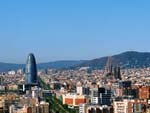 (Philippe Ruault) Ateliers Jean Nouvel: Torre Agbar, Barcelona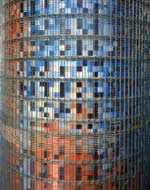 (Philippe Ruault) Torre Agbar façade detail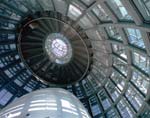 (Philippe Ruault) View up to Torre Agbar’s glass and steel dome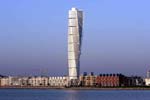 (Pierre Mens) Santiago Calatrava: Turning Torso, Malmö, Sweden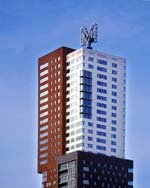 (Rob Hart) mecanoo architecten: Montevideo, Rotterdam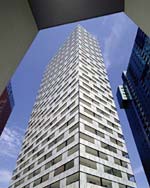 (Hertha Hurnaus) Delugan Meissl Architects: Wienerberg sky-rise, Vienna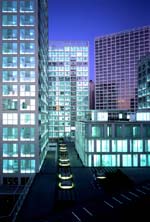 (Riken Yamamoto & Field Shop) Riken Yamamoto & Field Shop: Jian Wai SOHO, Beijing |
© 2006 ArchNewsNow.com